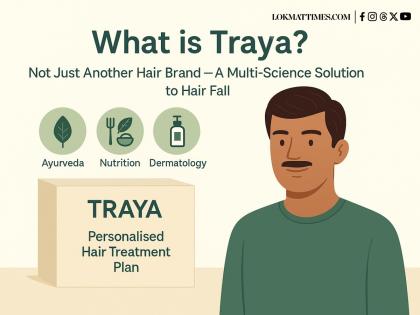Not Just Another Hair Brand: What Makes Traya Different
By Impact Desk | Updated: July 30, 2025 17:50 IST2025-07-30T17:47:05+5:302025-07-30T17:50:32+5:30
Hair fall is personal. For some, it's a minor annoyance. For others, it's a daily reminder in the mirror ...

Not Just Another Hair Brand: What Makes Traya Different
Hair fall is personal. For some, it's a minor annoyance. For others, it's a daily reminder in the mirror that something deeper might be off. And while the market is overflowing with shampoos, oils, and miracle serums, very few brands bother to ask why the hair fall is happening in the first place.
That’s where Traya enters the picture - and quietly rewrites the playbook.
At first glance, it looks like a wellness brand. Clean design, professional branding, and a presence across digital platforms. But when you actually look closer, it’s clear that Traya isn’t selling just another product. It’s offering a diagnosis-first, treatment-second model that most hair care companies don’t even touch.
It Starts with a Hair Test - and Goes Deeper
Most brands want you to add something to cart. Traya, instead, starts with a free diagnostic hair test. It doesn’t ask for your hair type or preferred fragrance. It asks questions about your stress levels, digestion, bowel movements, medical history, dietary habits, even sleep cycles.
That’s because Traya believes - and science supports - that hair fall is rarely just a surface problem. It’s often the visible symptom of a much deeper internal imbalance.
Once the test is done, a panel of three doctors evaluates your case:
- An Ayurvedic practitioner, who identifies constitutional imbalances (like high pitta or low agni)
- A nutritionist, who looks for vitamin and protein deficiencies or poor absorption
- A dermatologist, who recommends scalp-level interventions if needed
The result is a personalised plan - not a product kit - that includes internal supplements, topical applications, and routine follow-ups.
The Multi-Science Approach: Why It Works
Most hair fall treatments stick to one school of thought - Ayurveda, allopathy, or cosmetics. Traya combines three under one roof.
Here’s how each one plays a role:
- Ayurveda: Targets internal imbalances that affect metabolism, digestion, and stress response
- Nutrition: Corrects deficiencies like Vitamin D, iron, and protein - all common causes of chronic hair fall
- Dermatology: Addresses direct scalp issues, using FDA-approved solutions like Minoxidil or prescription serums
The idea is not to replace one science with another, but to use them together, in a coordinated, doctor-led format. This is especially important in cases where hair fall is due to more than one trigger - for example, a woman with PCOS and Vitamin D deficiency, or a man with chronic stress and gut issues.
Not Just About Regrowth - It’s About Balance
Many users report an unexpected benefit: improvements in areas unrelated to hair. Better digestion. Improved sleep. More stable mood. That’s because the plan doesn’t just treat follicles - it strengthens the body systems that support healthy growth in the first place.
It’s this deeper repair model that sets Traya apart from surface-level treatments. Of course, results aren’t instant - most users begin seeing a drop in hair fall by month 2 or 3, and regrowth by month 4 or 5. But the outcomes tend to be more lasting because they’re built on internal stability, not external masking.
A Brand That Doesn’t Just Sell, It Listens
Traya may have entered the market as a “hair care” company, but it’s gradually evolved into something bigger - a health protocol disguised as a hair plan. It doesn’t suit everyone. It’s not a quick fix. But for those who are ready to go beyond surface-level solutions, Traya brings in something most brands don’t even attempt: an actual diagnosis, followed by medically aligned care.
That doesn’t make it perfect. But it does make it different. And in this space, that counts for a lot.
Open in app